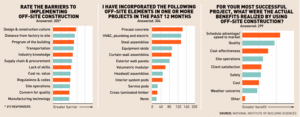Researchers trying to get a handle on trends and benefits of off-site construction say studies are limited by a lack of consensus about what really qualifies as prefabrication. That aside, 93% of 312 responders to a recent online survey indicate they have used, "to some degree," off-site fabricated components, with precast concrete the most frequently used. Of the responders, 83% say they will use off-site construction to the same degree or more in the next year.
"We need to draw the line to make the distinction about what is prefab and what isn't," says Jonathan W. Elliott, a professor of construction management at Colorado State University who led a recent New Horizons Foundation study of mechanical-electrical-plumbing systems delivery, titled "Off-Site Construction, Modularization and Sheet Metal Prefabrication: Trends, Current Practice and Recommendations."
"Variable-air-volume boxes have long been prefabricated, but that is not the same" as full-corridor systems of multitrade, multicomponent racks that have fire-rated corridor partitions, Elliott says.
Limits aside, the results of the online survey, released this month by the Off-Site Construction Council (OSCC) of the National Institute of Building Sciences, indicate trends and common barriers to off-site delivery, says Ryan Smith, a professor of architecture at the University of Utah and the OSCC's co-chairman.
Responders agreed that the biggest barrier to off-site is the traditional design and construction culture, with factory-to-site distance as the second biggest. They also rank schedule advantage—and/or speed to market—as the greatest benefit, followed by quality and cost-effectiveness.
Only 17% of respondents indicated they had ever used permanent modular construction, which some call volumetric modular. OSCC defines PMC as "an innovative, sustainable construction delivery method utilizing off-site, lean manufacturing techniques to prefabricate single or multistory whole building solutions in deliverable module sections."
Smith says a significant survey finding is that, to reap PMC's advantages, a building team must consider it early in the design and construction process. "There are negative cost and schedule impacts if you do not plan early," he says.
The survey also indicates the owner is not the one deciding to use PMC. Rather, designers and contractors typically make the decision to use modular.
"PMC is still being treated as a technique in a traditional process, rather than as an entirely new delivery process," says Smith.
To push the buildings sector toward higher-quality delivery of buildings, NIBS is holding a meeting on productivity and the workforce, at the Off-Site Construction Expo in Washington, D.C. on Sept. 23-24. Details are available from rcolker@nibs.org.
OSCC is preparing an off-site implementation guide. To help plan the guide, OSCC is conducting yet another online survey. The guide's initial release by early next year will cover preconstruction planning, including design parameters, contracts, procurement and software. It also will cover construction, including phasing, trade coordination, and transportation and installation logistics.





Post a comment to this article
Report Abusive Comment